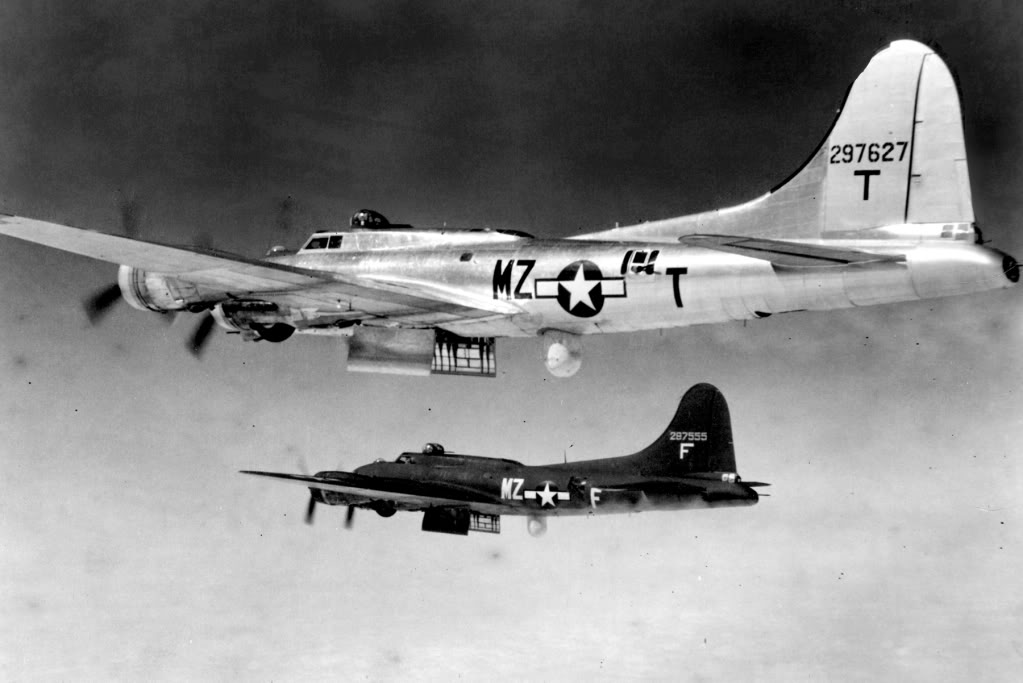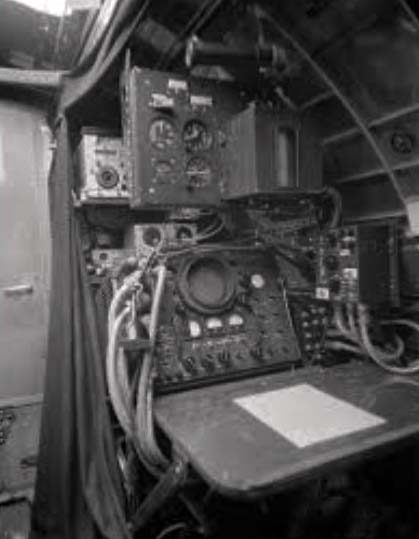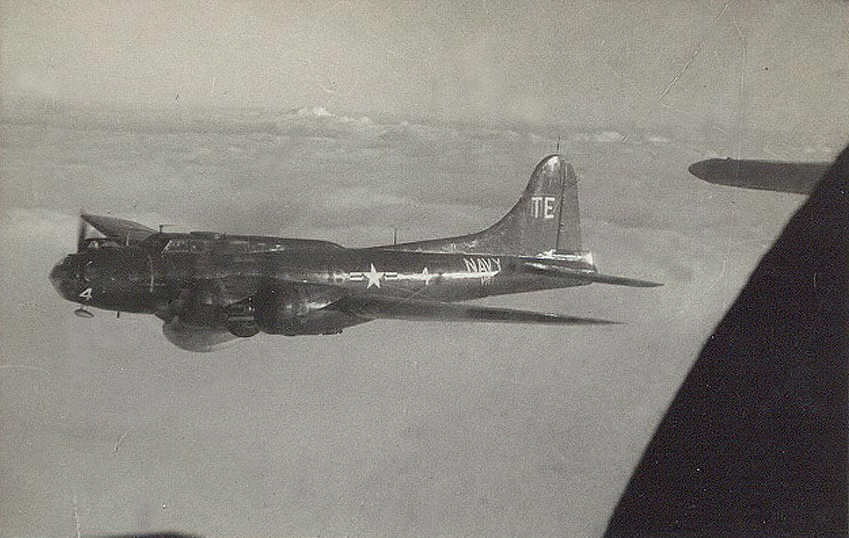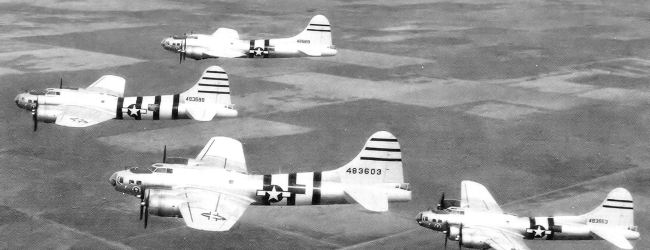
The most popular use of the B-17 on the postwar civilian market: aerial tankers for fighting forest fires. The aircraft pictured (43-38635) is currently on display at Castle AFB in Atwater, California as Virgin’s Delight.
It has now been two weeks since the tragic loss of B-17G 44-83575, better known as the Collings Foundation’s Nine O’ Nine. A testament to the pitiful regard in which we American citizens hold our government and legal system, the first reaction from those in the warbird community (once the shock had worn away) was: “It wont be long until someone tries to exploit this and ground us all.” We have come to expect it.
I have no desire to go into a political rant here but I do think it worth noting that, when it comes to political theater, too often emotion supplants fact. Vintage aircraft are subject to an overwhelming degree of government scrutiny and it is no stretch to suggest that they are usually maintained with greater care and expertise than your average commercial aircraft. Still, in a world where historic nose-art is altered because someone is offended, and airshows are cancelled because others find them ‘jingoistic’ and ‘noisy,’ the potential that this nation’s historic aircraft might be permanently grounded is a very real threat.
And, aside from having the freedom to operate historic aircraft, there have always been legitimate questions over the practicality of operating them. When a vintage aircraft like Nine O’ Nine is destroyed, the loss is painful – this is a piece of Second World War history that is not coming back. Arguments as to whether or not historic aircraft should even be operated at all, in light of their historical value, make valid points on both sides. There is no easy answer.
However, if historic aircraft are to be grounded, for whatever reason, there is another danger that must be acknowledged:
All over the world, one of the biggest problems plaguing this community is the need to bring static displays indoors. Make no mistake about it: there are one-of-a-kind historical pieces that are rotting in the exposed elements because their owners are unable to provide them with a temperature-controlled shelter. The end result always comes down to that awful dilemma of choosing which history is more important to remember.
For the Boeing B-17, this is particularly dangerous.
As you may recall from my article on B-17 survivors, unlike other Second World War heavy bombers, there are a fair number of B-17s still in existence. Of the 12,731 built in wartime, there remain 48 surviving examples; by comparison, the next most prolific survivor, the B-29, has 26 surviving examples. Now, of course it should never be forgotten why this is the case – the B-17 was not only still in production at war’s end, but it was also well-liked, making it attractive choice for whatever odd jobs it could perform.
When I wrote the survivors article, I wanted to convey how important it was that B-17 restorations begin showing greater care in returning them to their combat configurations. And, with the growing mortality rate of Second World War veterans, I still feel that this issue of accuracy is of utmost importance. However, I also noted that the extreme number of B-17 survivors “grants us an opportunity”:
B-17s served in a multitude of roles in the postwar years . . . [and] [t]here are multiple surviving examples of each of these still with us, though all but one have been altered to look like WWII veterans. . . . It is true that, with over 60 million dead, one can hardly go too far in remembering the sacrifices of the Second World War. Still, at times opportunities can be lost. For example, two of today’s surviving B-17s saw service as radar-carrying Pathfinders – a very big deal in the history of strategic bombardment. Yet, because they are not easily identifiable to the public, no effort has been made to preserve their Pathfinder status.
The B-17 was one of those rare aircraft whose contributions to aviation history extended far beyond its intended bombardment role. And, as the years go by and more and more people start asking pointed questions about preserving an aircraft of which we already have plentiful examples, the other contributions of the B-17 become ever more important. As such, this article will cover five of the B-17’s most important contributions to history that, in my opinion, deserve museum preservation.

B-17G Pathfinders 42-97627 and 42-97555 with the 96BG in mid-1944.
B-17G Radar-Equipped Pathfinder
No one factor frustrated the Second World War US bombing offensive over Europe more than weather. The entire concept of precision bombardment depended on the ability of the bombardier to clearly see his target, and a target that cannot be seen is a target that cannot be hit. If the US was going to bomb by day, there had to be some means of bombing through the cloudy skies of Northern Europe. The solution came from Great Britain.
Royal Air Force interwar doctrine had originally focused on the targeting of factory complexes, the underlying intention being to break down the morale of an enemy’s industrial base. When it became clear that such accuracy was impossible in total darkness, the leap to area bombardment was not a great one. Still, the release of a report chaired by David M. Bensusan-Butt in the autumn of 1941 caused a stir when it revealed that, on average, only a third of all bombs dropped that summer had landed within 5 miles of their intended targets – a figure worsened noting that only some 5% of each force was able to locate their targets in the first place. Following upon the RAF’s ‘area bombing directive,’ operations throughout 1942 restricted themselves to those targets within the range of GEE and OBOE – radio navigation systems that triangulated the bomber’s position via the timing of radio transmissions. Pathfinder bombers equipped with these systems marked the targets ahead of the strike force, ensuring that the following bombardiers had something they could see. It was radar which allowed RAF Pathfinders to finally strike beyond the range of GEE and OBOE.
First used on 30 January 1943 over Hamburg, ground-mapping radar was somewhat crude, being only effective at distinguishing bodies of water from land. Regardless, radar-equipped Pathfinders proved surprisingly effective throughout the Ruhr valley and Hamburg campaigns of 1943. In fact, the commanding general of VIII Bomber Command, BG Fred L. Anderson, Jr., personally accompanied multiple RAF Pathfinder operations, recommending its adoption for the US. While experiments with RAF radar sets – the H2S ‘Stinky’ – began on 27 September 1943, it was not until 3 November 1943 that US built radar sets – the H2X ‘Mickey’ – entered combat with US Pathfinders. The timing was not a coincidence. Just two days prior, USAAF chief GEN Henry H. Arnold issued a memo that US strikes were to no longer be halted on the basis of visibility – if the weather was cloudy, then the bombs were to be dropped by radar. Discouraging all talk of ‘area bombing,’ Arnold’s directive was a major event whose importance can hardly be overstated. The US Eighth and Fifteenth Air Forces dropped some 1.6 million tons of ordnance by the war’s end, nine-tenths of which was dropped after the issuance of Arnold’s directive. In total, 61% of all US bombs were via radar, with only 8% coming within 1,000 feet of their intended targets.

A radar operator’s station aboard a B-17 Pathfinder.
Of all the nontraditional roles in which the B-17 served, this one is undoubtedly the most important. Sadly, no effort has been made to preserve a Pathfinder B-17. Two currently survive: one being 44-8543 of the Liberty Foundation and the other 44-8846, a combat veteran currently with Fortersse Toujours Volante in France. Rather than commemorate their past as Pathfinders, both aircraft have been altered into faux-F-models. There are likely several reasons for this, the biggest being a reluctance to remove the bombers’ ball turrets (always a crowd-pleaser) in favor of the rather plain-looking radar domes. Since both of these examples are airworthy, there is little incentive for their owners to crowd their B-17s’ interiors with complex and little-understood equipment. Like the others listed , a Pathfinder would likely only see acceptance as a static display. Perhaps one day a major effort will be made on behalf of this important piece of aviation history.

SB-17G 44-83719 prepares for takeoff in Hayward, California on 20 April 1947.
SB-17G Search & Rescue Aircraft
When the Boeing B-29 entered service in 1944 with the Twentieth Air Force, it was originally intended that strategic operations against Japan would be flown out of free-China. However, with the inability of the Chinese military to protect US bases, the vast majority of B-29 operations were ultimately flown out of the newly-liberated Marianas Islands. This decision presented a whole new set of problems. The B-29 was the product of a rushed development, the resultant design being plagued with bugs, the most infamous of which was a frightening tendency toward engine fires. As such, throughout the B-29’s combat career, the overwhelming majority of losses came not from enemy action but system failures. Worse, whereas 8AF and 15AF operations over Europe generally entailed strikes some 650 miles in distance, 20AF operations against Japan more than doubled that average, with each mission being almost entirely over water. This meant that even slight problems often resulted in the loss of entire crews.
The need for effective air-sea rescue reached critical levels in late-1944/early-1945, the US Navy already being taxed in its use of submarines, destroyers, and flying boats. With the war in Europe coming to a close, the USAAF called on Boeing to produce a B-17 variant which could carry an air-dropped lifeboat, akin to the Uffa Fox design used by the RAF. Initially titled the B-17H, the new SB-17G ‘Dumbo’ carried a Type A-1 twin-engine lifeboat made by Higgins Industries of New Orleans. Made of laminated mahogany, the A-1 was 27 feet long and had a top speed of 8 mph (though it could be rigged with sails should its engines failed), its twenty waterproof compartments carrying enough clothing and equipment to care for a maximum of twelve passengers. The Higgins A-1 first saw use on 31 March 1945 when a PBY Catalina was crippled attempting to rescue a downed North American P-51 off the coast of Holland. Plagued by violent weather, repeated drops of RAF Fox boats saw the crafts break apart in the rough seas, the downed airmen finally being able to take shelter when a SB-17G dropped its A-1; the airmen were picked up four days later.
The SB-17G continued to see heavy use after the war, even being featured in the John Wayne film The High and the Mighty (1954). And, while it was supposed to be replaced by a similarly-altered B-29 – the SB-29 ‘Super Dumbo’ and its 30 ft Type A-3 aluminum lifeboat made by EDO – the SB-17G proved far more popular with its crews. The SB-17G last saw service in the Korean War, its air-sea rescue role being overshadowed by helicopters using wenches and rescue-swimmers. While the number of surviving A-1 lifeboats are unknown (if any), there are two SB-17Gs still in existence, both of which are currently in Brazil: 44-83718, on display at the Museu Aeroespacial in Rio de Janeiro, and 44-85583, on outdoor display at the Aeroporto Internacional in Recife.

PB-1W 44-83857 (VW-1) over the Sea of Japan during the Korean War.
Navy PB-1W Early Warning Aircraft
Necessity is the mother of invention and that was certainly the case regarding the development of early-warning radar in the Second World War. Complex and bulky, radar began with ground controllers directing interceptors to incoming targets, with heavy night fighters later carrying short-range radars to locate prey for themselves. Nevertheless, with early radars being so large and heavy, small airborne radars still required guidance from ground controllers to find the enemy’s general vicinity. It was this issue that the US Navy hoped to resolve with Project CADILLAC.
Named for the highest point in the Appalachian mountains, CADILLAC became an earnest need with the invasion of the Philippines in late-1944. The introduction of kamikaze attacks in October, and the equally trying Typhoon Cobra that December, highlighted the ineffectiveness of destroyer screens and observation aircraft in the early-warning role. CADILLAC sought to plug this gap by mounting a giant APS-20 radar to the belly of carrier-borne TBM Avengers, who would relay via VHF its radar picture to the shipboard Combat Information Centers (CIC). Unfortunately, while CADILLAC showed an effective range of some 100 miles, the Avengers could only stray but so far before disrupting its signal to the fleet. The solution was to make the entire CIC airborne. Enter the B-17.
Transferred to the US Navy under the designation PB-1 on 31 July 1945, some 48 B-17s were stripped of their defensive armament and painted in the Navy’s dark blue. These PB-1Ws carried the ASP-20 below the bombbay (with one exception), generating a single megawatt of power on a 10 cm wavelength, giving the bomber the ability to not only track aircraft, shipping, and weather, but submarine snorkels as well. Because of this, the PB-1W saw heavy usage throughout the early Cold War, serving alongside the PB4Y-2 (Navy B-24) in the skies over Korea. Arguably history’s first airborne early-warning and control (AWEC) aircraft, the PB-1W ended its career in 1955 when it was finally phased out in favor of converted Lockheed Constellations.
One Coast Guard and five Navy PB-1s still exist, all of but one of which remain in the United States. Two of these PB-1s are airworthy – 44-83872 (Texas Raiders of the Commemorative Air Force) and 44-85829 (Yankee Lady of the Yankee Air Museum) – but all have been converted to appear as wartime Army bombers. Like several of the aircraft types described in this article, the biggest obstacle to preserving the history of the PB-1W is largely the complexity of the equipment itself. However, it is also worth noting that the Navy has never had a good track record when it comes to the preservation of large aircraft, generally showing a preference toward carrier-borne displays. As such, while the PB-1W is an important part of Naval history, there are plenty of other large patrol bombers and flying boats equally deserving of attention.

QB-17G drones 44-83553, 44-83603, 44-83588, and 44-85819 in flight over New Mexico, circa 1946.
QB-17 Radio-Controlled Drone & DB-17 Mothership
Perhaps the most infamous postwar use of the B-17 was as a radio-controlled drone. The origins of this lay in the Second World War with Project APHRODITE. Frustrated by the inability of US airstrikes to penetrate German U-boat pens throughout late-1942/early-1943 because of a lack of large-capacity bombs, APHRODITE sought to turn older, war-weary B-17s in unmanned cruise missiles. Typically, the drone was flown by a volunteer pilot who transferred radio control of the bomber to a nearby controller aircraft (or ‘mothership’). When the Combined Chiefs of Staff demanded that strategic air operations be diverted toward German V-weapons in late-1944, USAAF leaders hoped that APHRODITE drones might be sufficient to pinpoint and destroy the launch-sites on their own. Beginning on 4 August 1944, APHRODITE proved a complete failure, the motherships struggling to maintain control of the drones in combat situations.
While APHRODITE was cancelled in January 1945, the drone concept was revived for postwar nuclear testing. Throughout a series of tests at Bikini Atoll (Operation CROSSROADS, 1 July – 25 July 1946), radio-controlled QB-17s were flown directly into the mushroom clouds, gathering data on the effects of radiation. This was immediately followed by a pair of QB-17s setting a world record for the longest unmanned flight on 6 August, flying the 2,174 miles between Hawaii and California. As government surplus, QB-17s were cheap, and ultimately the vast majority of postwar B-17s (some 107 aircraft) met their end as targets for missile testing. In fact, the QB-17 had the dubious honor of being the first aircraft shot down by a surface-to-air missile (SAM), with a drone being shot down by a Nike Ajax on 27 November 1951. With military stocks drying up, the last QB-17 drone was destroyed via air-to-air missile (an AIM-4 Falcon) on 6 August 1959.
A sad end to a proud aircraft, the tasks performed by these drone aircraft were valuable nevertheless. Nine of today’s surviving B-17s saw service as drone motherships (DB-17s), one of which is still airworthy: 44-83514, flying as Sentimental Journey with the Commemorative Air Force. Still, perhaps none are as historically important as Preston’s Pride (44-85738), the sole surviving aircraft to have participated in the nuclear weapons tests at Bikini. Preston’s Pride is currently on outdoor display in Tulare, California, and while her interior is quite bare, our friend Greg Stathatos has been instrumental in returning her to her original paint scheme.

B-17G 44-85531 was the property of Intermountain Aviation, a CIA front based in Marana, Arizona that trained operatives in SKYHOOK extractions.
Project SKYHOOK
Designed by the eccentric Robert E. Fulton, Jr., the Surface-to-Air Recovery System (STARS) was used by the Central Intelligence Agency (CIA) as a means for passing aircraft to retrieve agents while they were still on the ground. Basing his system on the manner in which trains pick up mail bags, Fulton’s invention was simple in concept by complex in execution. First, the agent attached himself to a weather balloon via a braided nylon tether, after which the SKYHOOK aircraft snagged the line, violently pulling the agent off the ground. Once airborne, the agent was reeled inside the SKYHOOK aircraft.
Details regarding SKYHOOK remain shrouded in secrecy, but we know that STARS testing began in 1950, using pigs to test the degree to which recovery might shock the agent (which was found less intense than parachuting). The earliest acknowledged STARS field test took place during the Korean War, with CIA agents John T. Downey and Richard G. Fecteau attempting to extradite an anti-communist operative out of Manchuria on 29 November 1952. The Douglas C-47 SKYHOOK aircraft that was sent to retrieve them was shot down and Downey and Fecteau were imprisoned until 1973, finally being released through the efforts of the Nixon administration.
The B-17’s contribution to SKYHOOK came with Project COLDFEET in 1962. Having discovered the existence of an abandoned Soviet drift station, the US Navy correctly assumed that the Soviets were tracking US submarine activity under the ice (just as we were doing with the Soviets) and wanted an assessment of Soviet tracking capabilities. On 28 May 1962, Boeing B-17G 44-85531 dropped Maj James Smith and LT Leonard A. LeShack over station NP-8, being retrieved, along with their goods, four days later by the same aircraft. Shortly after the exercise, the existence of SKYHOOK was revealed to the world when this same B-17 was shown in the James Bond film Thunderball (1965), being prominently featured at the film’s conclusion.
While the complete details of its CIA usage remain classified, we know that B-17G 44-85531 left the service in 1969, being refitted as a tanker aircraft for fighting forest fires. In 1985 she was sold to the Evergreen Aviation & Space Museum in McMinville, Oregon, where she was returned to her bomber configuration. Said aircraft was purchased by the Collings Foundation in 2015 with the intention of painting her as Outhouse Mouse (42-31636, 91BG) and putting her on tour alongside Nine O’ Nine. With the recent loss of Nine O’ Nine, speculation as to 44-85531’s future with the Colling’s Foundation has been rampant ever since.
